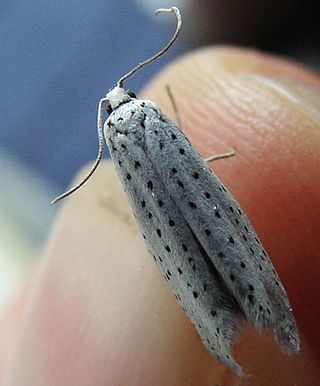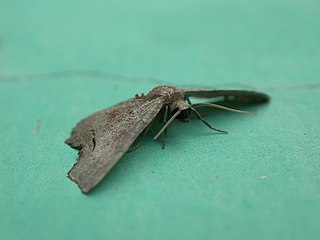
Urodidae, whose species are commonly known as false burnet moths, is a family of moths in the lepidopteran order. It is the type genus in the superfamily, Urodoidea, with three genera, one of which, Wockia, occurs in Europe.

Heliodinidae, commonly known as sun moths, is a family of small moths with slender bodies and narrow wings. Members of this family are found in most parts of the world. Heliodinid moths are brightly coloured day-flying moths. The base of the haustellum is bare. The scales on the head are compact and appear like a shield. Many Heliodinidae raise their hindlegs when resting but this is not a taxonomic feature and several genera like Epicroesa and Lamprolophus do not show this posture. Many Heliodinidae have the inner and outer spurs of the metatibia subequal. The larval host plants of the majority of species are in the Aizoaceae, Chenopodiaceae, Phytolaccaceae, Portulacaceae and Nyctaginaceae, all in the Order Caryophyllales. A few feed on Onagraceae, Araliaceae and Piperaceae. The larvae's feeding strategies include skeletonizing leaves, boring into leaf stems, leaf mining, and opportunistically invading cecidomyiid galls. The pupae have long stiff hairs on their back sides.
Metachanda is the sole genus in tribe Metachandini of moth subfamily Oecophorinae. Metachandini was originally described as family Metachandidae by Edward Meyrick in 1911, and at the time also contained the genus Chanystis, which is currently unplaced to tribe within Oecophorinae. It has also previously been described as tribe Metachandini of subfamily Gelechiinae.

Agathiphaga is a genus of moths, known as kauri moths. and is the only living genus in the family Agathiphagidae. This caddisfly-like lineage of primitive moths was first reported by Lionel Jack Dumbleton in 1952, as a new genus of Micropterigidae.

Yponomeutinae is a subfamily of "micromoths" in the lepidopteran family Yponomeutidae. As their scientific name implies, this is the subfamily containing the type genus of the ermine moths, Yponomeuta. The subfamily has worldwide distribution.
Lithoprocris is a genus of moths in the subfamily Arctiinae erected by Paul Dognin in 1899.
Atypha is a monotypic moth genus of the family Noctuidae erected by Jacob Hübner in 1821. Its only species, Atypha pulmonaris, was first described by Eugenius Johann Christoph Esper in 1790. It is found in southern and central Europe, northern Turkey, Transcaucasia and the Caucasus.

Diphtherinae is a monotypic subfamily of moths in the family Nolidae erected by Michael Fibiger and J. Donald Lafontaine in 2005. Its only genus, Diphthera, was erected by Jacob Hübner in 1809. The genus was moved from Noctuidae in 2013 after the phylogenetic analysis of Reza Zahiri et al. (2013).
Hapda is a monotypic moth genus of the family Erebidae described by Nye in 1975. It was first described by Francis Walker in 1863 as Dapha. Its only species, Hapda exhibens, was described by Walker in 1863.

Blepharoctenucha is a monotypic moth genus in the family Geometridae described by Warren in 1895. Its only species, Blepharoctenucha virescens, first described by Arthur Gardiner Butler in 1880, is known from India and Taiwan.
Caledasthena is a monotypic moth genus in the family Geometridae. Its single species, Caledasthena montana, is found in New Caledonia in the south-west Pacific Ocean. Both the genus and species were first described by Jeremy Daniel Holloway in 1979.
Celonoptera is a monotypic moth genus in the family Geometridae. Its only species, Celonoptera mirificaria, is found in south-eastern Europe. Both the genus and species were first described by Julius Lederer in 1862.
Ischnopteris is a genus of moths in the family Geometridae described by Jacob Hübner in 1823.
Ithysia is a monotypic moth genus in the family Geometridae. Its only species is Ithysia pravata. The genus was erected by Jacob Hübner in 1825, but the species had been first described by Hübner in 1813.
Megalotica is a genus of moths in the family Geometridae described by Zimmerman in 1958.
Syzeuxis is a genus of moths in the family Geometridae erected by George Hampson in 1895.

Xenozancla is a monotypic moth genus in the family Geometridae. Its only species, Xenozancla versicolor, is found in northern India. Both the genus and species were first described by William Warren in 1893.
Lithoprocris jason is a moth of the subfamily Arctiinae. It was described by Paul Dognin in 1899. It is found in Ecuador.
Lithoprocris methyalea is a moth of the subfamily Arctiinae. It was described by George Hampson in 1900. It is found in Bolivia.
Lithoprocris postcaerulescens is a moth of the subfamily Arctiinae. It was described by Rothschild in 1913.






